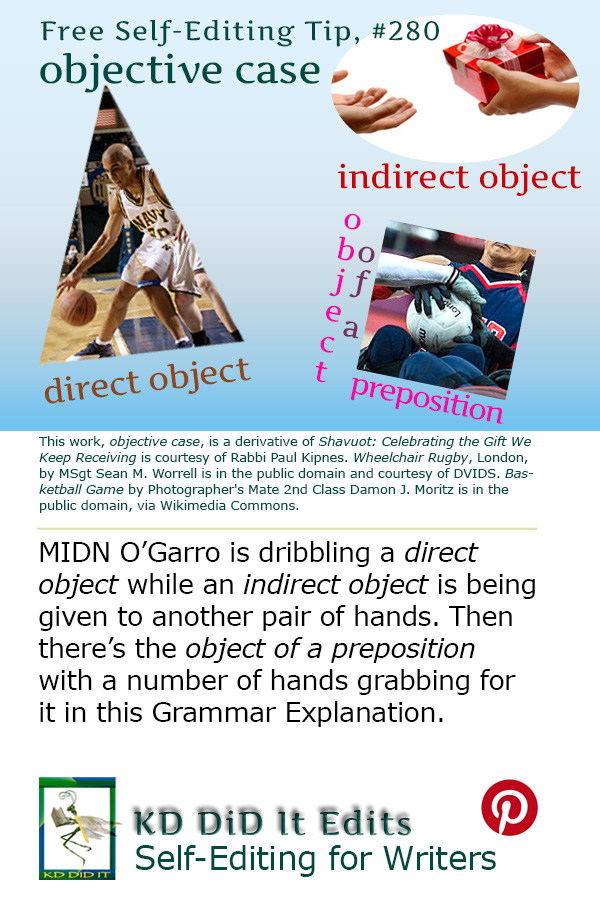Revised as of
13 Feb 2023
Objective Personal Pronouns
me
youhim
her
itus
themwhom whomever
“The objective case is the overall term for objects, whether they’re direct objects, indirect objects, or objects of a preposition. They’re used for nouns and objective personal pronouns which function as objects” (Shrives).
Three Types of Objective Case:
Mentions of the accusative case and the dative case crop up in grammar books and online sites. The accusative case functions to point out the direct object and is more frequently used when studying a language other than English. The dative case functions to point out the indirect object.
Grammar Explanations is . . .
. . . an evolving list of the structural rules and principles that determines where words are placed in phrases or sentences as well as how the language is spoken. Sometimes I run across an example that helps explain better or another “also known as”. Heck, there’s always a better way to explain it, so if it makes quicker and/or better sense, I would appreciate suggestions and comments from anyone on an area of grammar with which you struggle or on which you can contribute more understanding.
If you found this post on “Objective Case – Direct & Indirect Objects . . . & Objects of a Preposition” interesting, consider subscribing to KD Did It, if you’d like to track this post for future updates.
| Direct Object | |||||||||||||||||||||
| Definition: A direct object is the object of an action verb — what the verb is affecting, a.k.a., it receives the action.
Rule: Find the direct object by first finding the verb. Then ask what? or whom? |
|||||||||||||||||||||
|
| Indirect Object | ||||||||||||||||
| Definition: An indirect object receives the direct object.
A verb that acts to / for whom or to / for what followed by a noun or pronoun which is always in front of the indirect object, but the words to or for are never actually used. Rule: Find the indirect object by first finding the direct object (see the direct object table above). Then ask who/what will receive that direct object. |
||||||||||||||||
|
| Object of a Preposition | ||||||||||||||||||||||||||||
| Definition: The noun, noun phrase, noun clause, or objective personal pronoun after a preposition (see a list of common prepositions).
Caution: The object does not always follow the preposition. |
||||||||||||||||||||||||||||
|
C’mon, get it out of your system, bitch, whine, moan . . . which words are your pet peeves? Also, please note that I try to be as accurate as I can, but mistakes happen or I miss something. Email me if you find errors, so I can fix them . . . and we’ll all benefit!
Satisfy your curiosity about other Grammar Explanations by exploring its homepage or more generally explore the index of self-editing posts. You may also want to explore Book Layout & Formatting Ideas, Formatting Tips, Grammar Explanations, Linguistics, Publishing Tips, the Properly Punctuated, Word Confusions, Writing Ideas and Resources, and Working Your Website.
Resources for Objective Case – Direct & Indirect Objects . . . & Objects of a Preposition
Some of these links may be affiliate links, and I will earn a small percentage, if you should buy it. It does not affect the price you pay.
Shrives, Craig. “What Is the Objective Case? (with Examples).” Grammar Monster. n.d. Web. n.d. <https://www.grammar-monster.com/glossary/objective_case.htm>.
Pinterest Photo Credits:
Shavuot: Celebrating the Gift We Keep Receiving is courtesy of an article by Rabbi Paul Kipnes. Wheelchair Rugby, London, by MSgt Sean M. Worrell is in the public domain and courtesy of DVIDS. Basketball Game by Photographer’s Mate 2nd Class Damon J. Moritz is in the public domain, via Wikimedia Commons.


